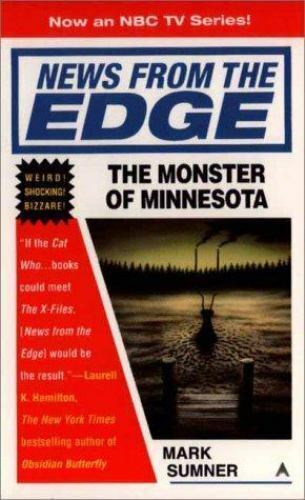|
MENU
Home
Books
Horror Film Aesthetics
Horror Film Festivals and Awards
Vampire
Nation
Pentagon Possessed
Cost of Freedom
Manhattan
Sharks
Halloween
Candy
Hollywood
Witches
Short Works
Pursuits
Actor
Film Festival Director
Editorial Services
Media
Appearances
Horror Film Reviews
Blogs
Horror Film Aesthetics
Communist Vampires
Horror Film Festivals and Awards
Other
Business
Satire
Nicolae Ceausescu
Commuist Vampires
Stalinist Zombies
L'Internationale Song
Links

|
 The
Monster of Minnesota is the first of Mark Sumner's "News
from the Edge" series, the other two being
Insanity, Illinois and
Vampires of Vermont. The
Monster of Minnesota is the first of Mark Sumner's "News
from the Edge" series, the other two being
Insanity, Illinois and
Vampires of Vermont.
The Chronicle (the 2001 Sci-Fi
Channel series) credits "News ¨from the Edge" as its
basis, yet the TV show so little resembles Sumner's books, I doubt
anyone would make the connection without the onscreen credit.
(Richard Matheson reportedly expressed surprise when he received a
remake royalty check for The Omega
Man, as he would not have guessed it was based on his
novel, I Am Legend.)
Perhaps The Chronicle's
onscreen credit for "News from the Edge" is some
contractual residue of the books' passage through Hollywood's
infamous "development hell." Sumner's books' covers make no
mention of the Sci-Fi Channel's "original series," but instead
proclaim: Now an NBC TV Series!
The Chronicle changed
everything about "News from the Edge" apart from its
premise. It's not an original premise: Reporter tracks monster.
That was the premise of Jeff Rice's 1971 novel,
The Night Stalker,
the basis for TV's
Kolchak: The Night Stalker. Which was an inspiration for
The X-Files.
Both The Chronicle and
"News from the Edge" are set at tabloids. Not like The
National Enquirer or Globe (which concentrate on
celebrities), but more like their poorer relations that still
cover Bigfoot and UFOs (e.g, The Weekly World News or
Sun). But though they cover similar terrain, the tabloid in
TV's The Chronicle (called
The World Chronicle) and that in Sumner's "News from the
Edge" (the Global Query) differ in tone, resources,
and attitude.
The World Chronicle has integrity to shame most major
media. ¨Everything it publishes is true. Based in New
York City (but obviously filmed in Canada), The World
Chronicle boasts an underground complex of space-age
investigative hardware that rivals that of the CIA, NSA, NASA, the
Illuminati, and most James Bond villains. Its high-tech paranormal
lab resembles (but surpasses) that of The Legacy group in
Poltergeist: The Legacy.
However, The Chronicle's
whimsical humor evokes She Wolf of
London, rather than the darker
Poltergeist: The Legacy). Its reporters are proud of their
paper, work as a team, and even like each other.
This is the TV series's claim to distinction: It violates tabloid
stereotypes. A high-tech tabloid, with proud reporters who tell
the truth about real-life Bigfoots and UFOs.

The Global Query in "News from the Edge" is a
more stereo typical tabloid. A cheap, sleazy ragsheet, based in
St. Louis, its contents are 99% fake. Sumner's heroine, reporter
Savannah "Savvy" McKinnon, lies to her editor, contemns her paper,
and dislikes her co-workers. This is in stark contrast to the
closely bonded team at The World Chronicle (as with so
many TV shows, a recent episode emphasized the theme of
"friendship").
Savvy wishes she worked for a "real" news publication. But though
the Global Query is a ragsheet, on rare occasions, as in
The Night Stalker,
Savvy encounters actual monsters. But whereas Kolchak reported for
a "real" news organization and only stumbled onto monsters by
chance, Savvy's monsters (and monster witnesses) simply phone in
to the Global Query.
Sumner's variation fixes Rice's implausibility problem. A tabloid
is a natural magnet for monster-sightings, whereas it's unlikely
that Kolchak would keep meeting monsters by chance. It is this
variation on Rice's formula that The
Chronicle takes from "News from the Edge," then
adding The Legacy's high-tech
gear, She Wolf of London's
whimsy, new friendlier characters, and a further variation on the
formula in that everything it publishes is true.
The Monster of Minnesota begins when a girl phones Savvy,
claiming that a lake monster killed her brother. Three others were
killed by this monster, making it an anomaly. Neither the Loch
Ness Monster, nor its less famous brethren lake monsters, were
ever alleged to kill anyone. Cynical in the Kolchak mold, Savvy
suspects a shark. (They sometimes find their way into lakes.) Soon
after arriving in Minnesota, she suspects murder.
The book is not really horror or sci-fi, but mystery. Its ¨spine
says Science Fiction, its title implies horror, but the (pre-Chronicle)
posts at Amazon indicate readers regard "News from the Edge"
as a mystery series. They have good reason. Structure, tone,
atmosphere, and characterization are that of a mystery, despite
the sci-fi/horror icons.

The story is told by Savvy in the first person. Although only 25,
her voice is that of a jaded sleuth. She is irreverent, cynical, a
frustrated romantic, a disillusioned idealist, self-deprecating
about her appearance, acknowledging her cowardice, yet capable of
courage when the occasion requires it.
Savvy's voice is not only world weary, it is hyperstylized. She
can't simply order some pie, but rather: "Besides, my nose was
under unfair assault from a selection of pies revolving in a
little glass case. Given an hour to set and sniff, I did in a
slice of chocolate and then ordered a slab of cherry with a glass
of milk to wash it down. At least it was skim milk." She
can't simply watch TV, but instead: "Ten seconds after we came
through the door, the phosphors were glowing and the laugh tracks
were crowing. Let us all praise the sitcom."
Savvy's voice remains consistent and keeps the story flowing, but,
while mystery buffs might like it, I found it irritating. Who in
real life says "phosphors" when they mean TV? This standard issue,
hard-boiled first person voice should be retired to satire. Not
that the book is funny. Savvy's voice is not so heavy-handed as to
inspire laughs, just odd enough to grate one's nerves.
Because her lean, jaded, hyperstylized voice is so common to
mysteries, Savvy becomes less distinct. We've heard her voice
before. She could be anyone. Yes, she has traits that are
distinct, if not unique. Her hair is a tangled mess. (She is often
unkempt, in tabloid stereotype style). She laments that she's too
short (forever reminding us that everyone towers over her) and too
fat. In deference to Nineties' sensibilities, her vices are fat
and cholesterol, rather than nicotine and booze.¨

In further deference to PC concerns, she packs Mace rather than a
Magnum. She self-righteously gets into people's faces, then
self-deprecatingly quips about how scared she was. I suppose some
readers will regard her as "plucky." I found her something of a
bully.
In the end, Savvy solves the mystery of the lake monster and ¨gets
her byline. To Sumner's credit, the monster is original and
unexpected, his clues well-laid. But the villain responsible for
the lake monster was never a mystery. Savvy had three suspects: a
man whose family includes Native Americans, a man dating an
environmental activist, and a man working for a pesticide
corporation. Think along PC lines, and you'll have little trouble
spotting the villain.
It's ironic that "News from the Edge" bears so little
resemblance to TV's The Chronicle,
because
The Monster of Minnesota is as insubstantial as a TV
novelization. A slight, thin book (198 pages) that flows well but
is forgettable. Reasonably enjoyable, but hardly compelling.
Readers often complain that "the book was better" but that's not
true here. If you enjoy The Chronicle,
don't assume you'll like "News from the Edge."

|






